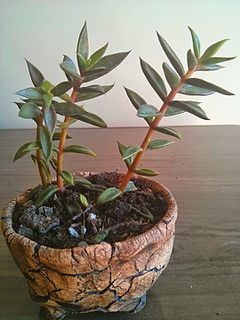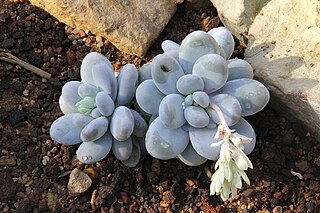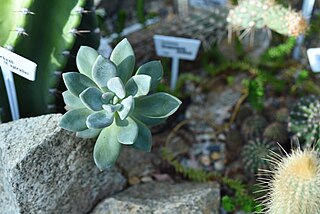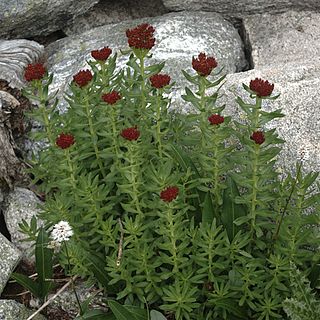 W
WThe Crassulaceae, also known as the stonecrop family or the orpine family, are a diverse family of dicotyledon flowering plants characterized by succulent leaves and a unique form of photosynthesis, known as Crassulacean acid metabolism (CAM). Flowers generally have five floral parts. Crassulaceae are usually herbaceous but there are some subshrubs, and relatively few treelike or aquatic plants. Crassulaceae are a medium size monophyletic family in the core eudicots, among the order Saxifragales, whose diversity has made infrafamilial classification very difficult. The family includes approximately 1,400 species and 34–35 genera, depending on the circumscription of the genus Sedum, and distributed over three subfamilies. Members of the Crassulaceae are found worldwide, but mostly in the Northern Hemisphere and southern Africa, typically in dry and/or cold areas where water may be scarce, although a few are aquatic.
 W
WAizopsis is a genus of the succulent family Crassulaceae, found in E Asia.
 W
WCotyledon is a genus of succulent plants in the family Crassulaceae. Mostly from Southern Africa, they also occur throughout the drier parts of Africa as far north as the Arabian peninsula.
 W
WCotyledon orbiculata, commonly known as pig's ear or round-leafed navel-wort, is a South African succulent plant belonging to the genus Cotyledon.
 W
WCotyledon tomentosa is a species of flowering plant in the family Crassulaceae, native to South Africa. It is a succulent evergreen shrub with large chunky ovate fuzzy green leaves. Its autonymous subspecies is known as the bear's paw because of the prominent "teeth" at the tips of its leaves. It forms large orange bell-shaped flowers in spring. In its native habitat, the Little Karoo region of South Africa, cotyledons usually grow in rocky quartz fields where they have excellent drainage provided by very porous soil.
 W
WCotyledon undulate, also known as silver crown or silver ruffles, is a small succulent shrub up to 50 cm tall. It has unusual grey undulating leaves that give it a very sculptural shape. Cotyledon undulata is perhaps the most widely grown Cotyledon. The stems are covered with a thick, white, coating. The leaves are shaped like scallop shells, grey-white to blue-grey, with wavy edges and a powdery waxy coating over the whole leaf. The flowers are orange to yellow.
 W
W× Cremnosedum is a hybrid genus produced from crosses involving the genera Cremnophila and Sedum. This bigeneric name was first published in 1981 with the introduction of the cultivar 'Little Gem' in an article advertising plants offered by the International Succulent Institute in the Cactus and Succulent Journal, the journal of the Cactus and Succulent Society of America. The 'Little Gem' cultivar was made by Mrs. and Mr. Robert Grim of San Jose, California and is described as producing a low mat of small rosettes. It prefers direct sunlight and produces small yellow flowers on short stalks.
 W
WDiamorpha is a genus of plants in the family Crassulaceae. It is sometimes included within the genus Sedum. It is monotypic, including only the species Diamorpha smallii, an endemic of the southeastern United States. It becomes active in late fall and winter, blooms in late March, then dies. It has red succulent leaves that act to reflect light and hold water. Diamorpha smallii is found primarily on solution pools, shallow basins on rocky outcrops that contain seasonal pools. The plant is mainly found in Georgia, though populations have also been noted in Alabama, South Carolina, North Carolina, Tennessee, and Virginia. It is listed as an endangered species by the Tennessee Department of Environment and Conservation.
 W
WHen and chicks is a common name for a group of small succulent plants, a term that indicates a plant that possesses enlarged parts to store water. It belongs to the flowering plant family Crassulaceae, native to southern Europe and northern Africa. The plants grow close to the ground with leaves formed around each other in a rosette, and propagating by offsets. The "hen" is the main, or mother, plant, and the "chicks" are a flock of offspring, which start as tiny buds on the main plant and soon sprout their own roots, taking up residence close to the mother plant.
 W
WHylotelephium is a genus of flowering plants in the stonecrop family Crassulaceae. It includes about 33 species distributed in Asia, Europe, and North America.
 W
WHylotelephium erythrostictum, commonly known as garden stonecrop, is a herbaceous perennial plant in the genus Hylotelephium, belonging to the family Crassulaceae.
 W
WJovibarba is a small genus of three species of succulent flowering plants in the family Crassulaceae, endemic to mountainous regions in the southeastern quadrant of Europe. The genus is sometimes classified as a subgenus of Sempervivum, to which it is closely related. Jovibarba have pale-greenish-yellow or yellow actinomorphic flowers with about six petals, while Sempervivum have generally pinkish flowers with around twice as many petals, which open more widely than jovibarba flowers. The common name hen and chicks is applied to some Jovibarba species.
 W
WJovibarba globifera, common name Rolling Hen-and-chicks, is a species of succulent flowering plants in the family Crassulaceae.
 W
WJovibarba heuffelii, common name Hen-and-chickens, as a plant species native to the Balkans and to the Carpathians in Europe but reportedly naturalized in Wisconsin and probably in other parts of North America. It grows on rocky outcrops.
 W
WLenophyllum is a genus of flowering plants in the family Crassulaceae. The roughly seven species it contains are distributed in Texas in the United States and northeastern Mexico. Some authorities place it in the genus Sedum. Plants in this genus are distinguished from Sedum species by the presence of terminal inflorescences, erect petals, and opposite leaves. The name is derived from the Ancient Greek words ληνός (lenos), meaning "trough", and φύλλον (phyllon), meaning "leaf."
 W
WOrostachys is a genus of the succulent family Crassulaceae that contains about 15 species. It is a biennial herb growing in China, Japan, Kazakhstan, Korea, Mongolia, Russia. Eight species occur in China.
 W
WOrostachys japonica (Japanese:爪蓮華、昭和、秀女)also known as rock pine is a species of flowering plant in the family Crassulaceae. Native to East Asia. Its main habitat is on the surface of mountain rocks in Korea, Japan and China.
 W
WPachyphytum is a small genus of succulents in the family Crassulaceae, native to Mexico, at elevations from 600 to 1,500 metres. The name comes from the ancient Greek pachys (=thick) and phyton (=plant) because of the shape of the leaves.
 W
WPachyphytum bracteosum, the large-bracted pachyphytum, is a perennial succulent native to Mexico, occurring on rocks at altitudes between 1,200–1,800 m (3,900–5,900 ft). The succulent has a diploid number of 66 or 132. The closest relatives of the plant are Pachyphytum oviferum and Pachyphytum longifolium.
 W
WPachyphytum hookeri is a species of plant in the genus Pachyphytum of the family Crassulaceae.
 W
WPachyphytum oviferum, the sugaralmond plant or moonstone, is a species of plant in the genus Pachyphytum.
 W
W× Pachyveria is a hybrid succulent. They typically grow to 2–6 inches. They grow best in soil full of phosphorus and potassium, but low in nitrogen. Pachyveria are a hybrid cross between Pachyphytum and Echeveria. × Pachyveria glauca 'Little Jewel' is a cultivar of × Pachyveria.
 W
W× Pachyveria glauca 'Little Jewel' succulent plants are hybrids in the nothogenus × Pachyveria. It is a versatile plant, thriving in the garden and in containers.
 W
WPetrosedum is a genus of the succulent family Crassulaceae.
 W
WPhedimus is a genus of the succulent family Crassulaceae, with about 18 species, distributed in eastern Europe and Asia. The genus is described with two subgenera, but one of these is also recognized as a separate genus, Aizopsis.
 W
WPetrosedum is a genus of the succulent plant family Crassulaceae.
 W
WPrometheum is a genus of plants in the family Crassulaceae.
 W
WRhodiola is a genus of perennial plants in the family Crassulaceae that resemble Sedum and other members of the family. Like sedums, Rhodiola species are often called stonecrops. Some authors merge Rhodiola into Sedum.
 W
WRhodiola integrifolia is a species of flowering plant in the stonecrop family known by the common names ledge stonecrop, western roseroot, and king's crown. It is native to north-easternmost Russia, including Kamchatka, and western North America, where it grows in mountainous habitat in subalpine and alpine climates, including meadows, cliffs, and talus. It is a perennial herb producing a stout stem from a fleshy, branching caudex, reaching a maximum height near 30 centimeters. The fleshy leaves are alternately arranged on the stem, widely lance-shaped to oval and pointed, flat but upcurved toward the tip, reaching 2.5 centimeters long. They are green when new and age to orange, rose, or red. The inflorescence is a dense cyme of up to 50 flowers with fleshy petals in shades of bright red to deep purple. The fruits are red, rounded ovals with pointed tips.
 W
WRhodiola rhodantha, common name redpod stonecrop or queen's crown, is a perennial flowering plant in the family Crassulaceae.
 W
WRhodiola rosea is a perennial flowering plant in the family Crassulaceae. It grows naturally in wild Arctic regions of Europe, Asia, and North America, and can be propagated as a groundcover. Rhodiola rosea has been used in traditional medicine for several disorders, notably including treatment of anxiety and depression. As of 2019, there is no high-quality clinical research to indicate it is effective for treating any disorder, and the United States Food and Drug Administration has issued several warnings to manufacturers of R. rosea dietary supplements for making false health claims about its safety and efficacy.
 W
WRosin is a glycoside ester of Cinnamyl alcohol and a constituent of Rhodiola rosea.
 W
WRosiridin is a chemical compound that has been isolated from Rhodiola sachalinensis. Rosiridin can inhibit monoamine oxidases A and B, possibly meaning that the compound could help in the treatment of depression and senile dementia.
 W
WRosularia is a small genus of the family Crassulaceae. It includes about 28-35 species from Europe, the Himalayas, and northern Africa. It is a larval host for the butterfly Parnassius apollonius.
 W
WSedella is a small genus of flowering plants in the family Crassulaceae. There are approximately 7 species, all native to California, United States, one with a distribution extending into Oregon. These are petite succulent plants growing a few centimeters tall and bearing tiny yellowish or brownish flowers. Mock stonecrop is a common name for these plants.
 W
WSedella pumila is a species of flowering plant in the family Crassulaceae known by the common name Sierra mock stonecrop. It is native to California, where it grows in the North Coast Ranges and adjacent sections of the Central Valley to the Sierra Nevada foothills. It is a plant of vernal pools and similar habitat, growing in rocky and gravelly flats of serpentine soils, limestone, and soils of volcanic origin, often alongside mosses. This is an annual herb growing 2 to 17 centimeters high, in shades of green, yellow, and red. It has small knobby succulent leaves each a few millimeters long. The flowers atop the threadlike stems have fleshy sepals and yellowish petals a few millimeters in length. The flowers have a musty scent.
 W
WSempervivoideae is the largest of three subfamilies in the Saxifragales family Crassulaceae, with about 20–30 genera with succulent leaves. Unlike the two smaller subfamilies, it is distributed in temperate climates. The largest genus in this subfamily is Sedum, with about 470 species.
 W
WSinocrassula is a genus of succulent, subtropical plants of the family Crassulaceae.
 W
WThompsonella is a genus of plants in the family Crassulaceae. It includes about eight species endemic to Mexico.
 W
WVilladia is a genus of plants in the family Crassulaceae. It includes about 25 to 30 species distributed from Texas to Peru.